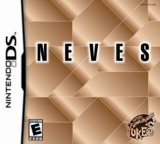Think spatially, think Neves.
Graphics: 4
Sounds: 7
Value: 10
Tilt: 7
At first glance, you’ll probably wonder what on earth is Neves is? Some will say it’s Portuguese for snow (in plural form); others may say it’s a common surname in Brazil (check out those soccer player’s surname and you’ll see) and yet the clever ones will say it’s ‘seven’ backwards (close but no cigar). Neves is indeed seven backwards but the style of game play is none other than solving a massive five hundred plus tangram like puzzles for the DS.
To anyone who is unfamiliar to what a tangram is, it derives from two words: ‘tan’ meaning pieces and ‘gram’ meaning pictures. Now if you add the title ‘Neves’ into the equation you’ll have the general gist of the game: making shapes with the same seven pieces. Yet the DS version of tangram doesn’t use the exact seven pieces but a slightly modified version of the original seven piece Chinese version.
There are three main playing modes in Neves being silhouettes: the normal version where there’s no time or move restriction; time pressure: trying to solve the puzzle within three minutes and if you manage to clock it under one, a gold star is rewarded and lastly seven steps where every move counts therefore there's no room for error.
Each silhouette are categorised under four ‘rooms’ and each room has three levels with approximately forty five puzzles each. The only way to unlock the next room is to complete the previous room in any of the three different modes so there's ample of puzzles to solve. Arming with the stylus in hand, you will be flipping and rotating all the seven pieces until they are precisely connected so you can move on to the next one.
Visually the game isn’t exactly the prettiest however the game isn’t designed for intense graphics as after all it’s a puzzle game; yet the entire package is still appealing enough to serve its purpose. It’s like comparing a puzzle book to a comic strip where just because the puzzle book mainly has black and white pictures its real purpose is to fry up that grey matter and the comic strip is to visualise (graphically intense). Not all is lost though as you do have the option to change the colour of the pieces or if you prefer to randomise the effects.
The sounds are basic but again like the graphics do serve the purpose of the game. In hindsight it’s actually quite soothing as some puzzles at first glance can look damn right impossible to solve (as a sidenote, every puzzle can be solved so there’s no fallacy here). There are a few jazz like type musical pieces but at times can be a royal pain to listen to as they're all looped together, but of course you can switch it off or listen to some Café Del Mar. Yet like the graphics, you can change the sounds under the options menu.
Considering there are over five hundred puzzles to solve within three different modes, you’ll be spending some serious time to finish off the entire game. But like all puzzle games or books, the game isn’t designed for serious playing but for causal ‘pick me up’ type; especially if you are waiting for the train, bus or even a friend. And if you happen to find another person with the same game, you can hook it up for some multiplayer fun and see who has the total bragging rights.
Neves isn’t a serious game; it’s designed to fire up those brain cells by thinking spatially and there’s none other that can do this effectively than on the DS. Like similar types of games that really challenges your thought pattern (e.g. brain training), Neves on the surface doesn’t put the player on the spot as the presentation is quite entertaining and fun-looking to boot. There are well documented instances that Neves is used in schools to teach children how to think spatially therefore places this ‘age old debate’ of whether gaming is bad for you right into the bin. Overall, it’s good fun to anyone who likes a casual challenge.

